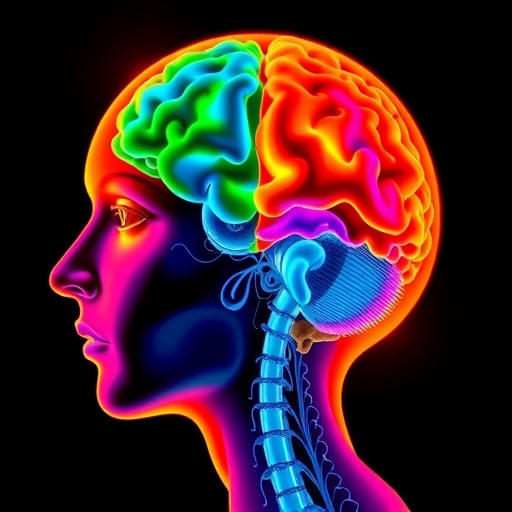In a groundbreaking study, researchers have unveiled significant differences in brainstem connectivity among individuals based on sex and menopausal status. The investigation, led by Kilpatrick et al., provides insights that could reshape our understanding of how neurological structures operate differently in men and women. This research is particularly relevant in today’s context, where increasing attention is being paid to sex-specific health issues and their implications on mental and physical well-being.
One of the most striking findings in this research is the clearer delineation of brainstem connectivity patterns between genders. Traditionally, the brain has been seen as a largely homogeneous organ, but this study challenges that notion by shedding light on how gender influences neural pathways. The brainstem, a crucial area responsible for basic life functions, has now emerged as a key player in understanding these biological differences.
The significance of the brainstem in human biology cannot be overstated, as it regulates essential functions such as heart rate, breathing, and sleep. What the study reveals is that variations in this region may also correlate with broader physiological and psychological differences observed in males and females. Particularly, factors such as hormonal fluctuations and reproductive status appear to significantly influence brain connectivity.
Moreover, the study emphasizes the role of menopause in altering brainstem connectivity. For women, this transition represents not just a significant biological change but also a time when brain structure and function may adapt significantly. By focusing on a range of healthy participants, the research ensures that these observations are not clouded by underlying health conditions, offering clearer insights into how sex and age-related transitions can shape our neural architecture.
Kilpatrick and her team adopted advanced neuroimaging techniques to map out these differences. Functional magnetic resonance imaging (fMRI) was employed to assess brain activity and connectivity patterns in real-time, offering a window into the dynamic workings of the brainstem. Participants went through a series of tasks designed to activate various cognitive and physiological responses, allowing scientists to pinpoint how connectivity varies across different demographic groups.
The results revealed that men and women display distinct connectivity patterns even during rest, suggesting that the neural wiring of the brain might vary significantly from an early age. Furthermore, these variations become even more pronounced for women as they navigate the menopausal transition. This period, characterized by significant hormonal shifts, not only affects physical health but also appears to intertwine with cognitive functions and emotional processing.
Beyond the immediate implications of these findings for individual health, the research also raises questions about the broader societal perceptions of sex differences in medicine and psychology. For decades, many clinical trials have predominantly focused on male subjects, leading to a data gap that has overlooked the specific health requirements and responses of females. The insights from Kilpatrick’s study underscore the urgency of incorporating sex as a critical variable in health research.
As the scientific community continues to unravel the complexities of the brain, particularly regarding connections to physical and mental health, these findings pave the way for more personalized treatment strategies. By understanding how brainstem connectivity varies according to sex and menopausal status, healthcare providers can better tailor interventions, whether for mood disorders, cognitive decline, or other related health issues.
With mental health increasingly being recognized as a public health priority, this research aligns with ongoing efforts to include a diverse range of subjects in clinical studies. It serves as a clarion call to recognize that the experiences of women, particularly during pivotal transitions like menopause, require closer examination and more nuanced approaches in both research and practice.
The commitment to exploring these differences goes hand in hand with encouraging a more informed dialogue about sex and neuroscience. As awareness grows, it becomes increasingly important to emphasize how individuality in biological and hormonal profiles shapes not only health outcomes but also personal experiences. Education and advocacy are essential to bridge the gap in understanding and treatment options.
In conclusion, Kilpatrick et al.’s research not only marks a significant step forward in our understanding of brainstem connectivity differences but also highlights the necessity for a greater acknowledgment of sex and hormonal influences in neuroscience. With ongoing advancements in neuroimaging and a growing awareness of gender-specific health issues, the landscape of neuroscience is poised for transformation.
As we advance our understanding, we must remain vigilant about ensuring that this knowledge translates into meaningful improvements in health outcomes for both men and women. The study sets a precedent for future research, inviting further exploration of how biological sex and reproductive stages impact brain function, ultimately enhancing individual care based on a deeper comprehension of sex-specific needs.
Subject of Research: Differential brainstem connectivity according to sex and menopausal status in healthy male and female individuals.
Article Title: Differential brainstem connectivity according to sex and menopausal status in healthy male and female individuals.
Article References:
Kilpatrick, L.A., Church, A., Meriwether, D. et al. Differential brainstem connectivity according to sex and menopausal status in healthy male and female individuals.
Biol Sex Differ 16, 25 (2025). https://doi.org/10.1186/s13293-025-00709-4
Image Credits: AI Generated
DOI:
Keywords: Brainstem connectivity, sex differences, menopausal status, neuroimaging, hormonal influences, personalized medicine, cognitive functions, mental health.




